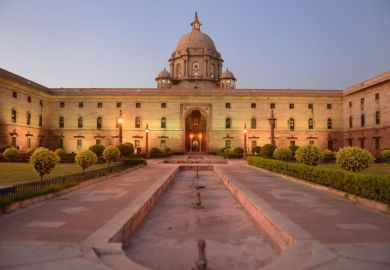Last August, the University Grants Commission – India’s main regulatory body for higher education – announced a new initiative to select 20 “Institutions of Eminence”. Of those, 10 were to be chosen from among public universities and 10 from private ones.
The selected public institutions are to receive an additional Rs10 billion (about £110 million) and will enjoy near-complete autonomy from the UGC, which is widely considered a hindrance to the emergence of world-class universities in India.
Only two Indian institutions are in the top 500 of the 2018 Times Higher Education World University Rankings. The government’s expectation is that within 10 to 15 years, its Institutions of Eminence will either break into the top 500 or, if they have already done so, improve their rank further.
In early July, however, the government announced the names of the eligible institutions – and there were only six. From the public sector, these were the Indian Institute of Science (IISc), and the Indian Institute of Technology Bombay and the IIT Delhi; from the private sector were the Birla Institute of Technology and Science Pilani, Manipal University and the Jio Institute.
The public institutions are already among the top 600 in the THE rankings, with the IISc in the top 300 and IIT Bombay in the top 400. But of the private institutions, Jio is an as-yet-unbuilt greenfield institution, backed by the billionaire Mukesh Ambani’s Reliance Industries. The other two are well behind the best public institutions in the country and do not figure among the global top 800. Moreover, for these private universities, chasing world rankings will be that much harder because they are not entitled to any financial support from the government.
In identifying only six eminent institutions, the government overruled its own selection committee. The Empowered Experts Committee, led by former chief election commissioner N. Gopalaswami, had proposed eight public and three private institutions in its report. Presumably, officials made the cull of public institutions to maintain numerical parity between the public and private sectors, but the decision has generated intense criticism.
One major bone of contention is the exclusion of a few other IITs that are already among the top 600 institutions in the world (those at Kanpur, Kharagpur and Roorkee). The other main criticism is the inclusion of Jio, which one commentator mocked as “a paper institution dreamt up by a billionaire”. The Indian historian and columnist Ramachandra Guha was more circumspect in describing Jio’s selection as an “altogether puzzling choice”. Others found fault with the UGC’s decision to make non-existent institutions eligible in the first place.
But others supported the government’s decisions. The Columbia University economist Arvind Panagariya, who until recently worked with the Indian government’s flagship thinktank NITI Aayog, claimed that Jio was “India’s greatest hope”. Panagariya, who had not previously expressed any view on the IoE initiative, added that given India’s limited financial resources, “the initial decision to go with as many as 10 public universities and 10 private ones was a flawed one”. This defence sounds flimsy, however, coming from an economist who is seen as a bit of a cheerleader for the current government.
For its part, the government clarified that Jio’s official classification was as a “to-be-eminent” institution; it will first be given a “letter of intent” requiring it to establish itself within three years, after which the eminence tag will be awarded. But there was yet more drama. On 25 July, it was announced that BITS Pilani, one of the three selected private institutions, would also have to wait for its eminence tag because it is currently involved in a legal dispute with the UGC. This, in effect, reduced the number of eminent private institutions to one.
The IoE initiative has looked clumsy from the start, both in its conceptualisation and its implementation. Some of those concerned about the broken state of India’s higher education sector might have naively hoped for the best when the IoE programme was launched. But even its supporters are now left flummoxed by the thoughtless and unprofessional manner in which the government has handled the project.
Pushkar is director of the International Centre Goa, in Goa, India.
POSTSCRIPT:
Print headline: Decreasing circles of eminence
Register to continue
Why register?
- Registration is free and only takes a moment
- Once registered, you can read 3 articles a month
- Sign up for our newsletter
Subscribe
Or subscribe for unlimited access to:
- Unlimited access to news, views, insights & reviews
- Digital editions
- Digital access to THE’s university and college rankings analysis
Already registered or a current subscriber?







